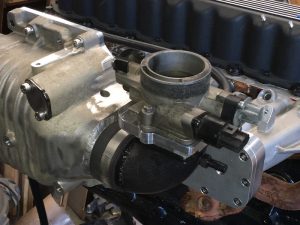Does a faulty throttle body make car slow?

A faulty throttle body is a significant inconvenience that could harm your vehicle. There are some important things to note about the causes of a faulty car throttle body. The throttle body is responsible for sucking in the air that the combustion process utilizes.
The combustion process within the car engine is responsible for producing power necessary for starting and moving the car. This process requires a perfectly balanced air and fuel mixture ratio. This balance relies on a throttle body and throttle position sensors that are in perfectly working condition.
Some small car engine sizes in terms of power production have one throttle body. But their performance can be improved by installing small engine modifications. Mean while there are high power production cars that have two or more throttle bodies.
What is the car throttle body.
The throttle body is the part of the car transmission that sucks in air into the combustion chamber. It has two important features; that is, the throttle butterfly valve and a throttle position sensor. Both of these ensure engine power balances alongside engine rotation per minute RPM.
Further, throttle body works alongside the throttle position sensor to help attain a perfect fuel and air mixture ratio. The throttle sensor exchanges data with the accelerator, the throttle butterfly valve and the fuel injector. The flow of information starts from the accelerator when the driver presses the gas pedal.
The throttle position sensor picks this data and assess the position of the butterfly valve. If the valve isn’t open enough the engine control module instructs it to open some more. Air then goes through from the air intake. Afterwards the throttle position sensor communicates with the fuel injector to release fuel from the engine tank. The mixture of fuel and air must be at a balance in order for the power to get to the engine for acceleration.
What happens when you drive with a faulty throttle body?
It’s not recommended for you to keep driving when the throttle body is faulty. That’s because there are a lot of things that could go wrong within the car. A faulty throttle body happens to be connected to the constituent parts that have been mentioned above. That is; the throttle sensor and the butterfly valve.

1. Damaging the oil in the oil tank.
The throttle position sensor’s responsibility of ensuring a balance of the air/fuel mixture ratio is responsible for this. When the throttle sensor gets data from the accelerator it opens the butterfly valve according to the engine’s power demands. Now this sensor also instructs the fuel injector the amount of fuel to be sent from the fuel tank.
Remember that this mixture’s ratio has to balance. Now if the throttle position sensor is faulty, there will be an imbalance of this ratio. Afterwards, the fuel will not be fully burnt.
The results of this is having excess fuel that will be eliminated from the combustion chamber. This fuel leaves the engine though the exhaust. Alternatively, it may leak into the oil tank. Causing the oil to change form hence becoming ineffective at its functions. The purposes of car engine oil are to offer lubrication and cooling effects.
2. Damaging vital engine parts.
This is due to the effects of unburnt fuel leaking into the oil tank. The vital engine parts rely on the oil to get lubrication and cooling. Now if the oil’s characteristics has changed due to fuel, the oil won’t be able to serve the engine parts well. This will cause damage to those parts if you keep driving with a faulty throttle body.
3. Damaging the catalytic converter.
The catalytic converter is responsible for transforming toxic gases in exhaust fume to non toxic. This happens because it is capable of catalyzing a redox reaction which converts the toxic gases in exhaust fumes. Well, how does a faulty throttle body cause damage to this catalytic converter?
When the fuel is unburnt within the combustion chamber due to a faulty throttle body, it flows out. The fuel may flow out to the oil tank or to the exhaust pipe. The fuel flowing through the exhaust pipe will have to pass through the catalytic converter. This fuel will cause damage to the catalytic converter because it will interfere with its functionality. Since the catalytic converter only handles gases instead of fluids.
4. Damaging the oxygen sensor.
The oxygen sensor works alongside the catalytic converter. It detects how much unburned oxygen is present in exhaust fumes. The sensor communicates if the mixture of air and fuel is burning rich or lean. If it’s reach, there is too much fuel meaning that there is insufficient air. While, if it’s lean there is too much oxygen meaning the oxygen is insufficient. This data goes to the on onboard computer.
However, if the throttle body is faulty, the rich exhaust fumes passes through the exhaust pipe. Too much unburned fuel is not a good thing for the oxygen sensor. It may damage it while passing out through the exhaust pipe.






